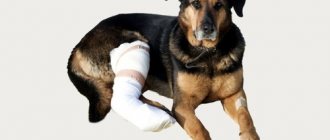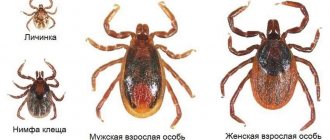Often, a dog owner notices that his pet is “crying.” Flowing tears leave wet marks on the animal's face and color the corners of the eyes brownish or reddish.
Why do my dog's eyes water? Most often this is due to the breed characteristics of the animal or foreign particles getting into the eyes, but sometimes the problem can be more serious and require the help of a veterinarian.
Causes
Normally, dogs may leak a little tears, but if the tearing becomes too profuse and bothers your pet, then this is a signal that the process has gone beyond what is natural.
Tear fluid has antibacterial properties and helps protect and moisturize the cornea of the eye. With the help of tears, all foreign objects and pathogenic microorganisms are removed from the surface of the eyeball.
Some dog breeds are characterized by excessive lacrimation, this is due to the size of the animal or the anatomical features of the development of the skull and eyes. Thus, tears often flow from the eyes of small dogs, for example, toy terriers, due to their size.
A short muzzle with a flattened nose is also a cause of eye discharge in Pugs, Shar-Peis and other breeds. From this we can conclude that if you have a puppy of this breed, he will have a predisposition to lacrimation.
But, if your dog’s eyes are too watery, the reasons for this may be:
- pollution with sand, dust, debris;
- allergies to food, household products;
- owners smoking;
- irritation of the eyeball by hair or eyelashes;
- entropion of the eyelid;
- problems with the lacrimal canal - an inflammatory process in it, blockage or a congenital anomaly of the canal;
- eye injury;
- infectious diseases.
In the case of pathological lacrimation, the volume of tear fluid increases, it becomes opaque, and this process causes discomfort to the dog.
Prevention of hyperemia
To prevent your dog’s eyes from turning red and watery, you need to follow simple preventive recommendations:
- It is necessary to monitor the pet’s health and regularly show it to the veterinarian. If signs of any disease appear, immediately undergo a full examination and begin treatment.
- Carry out regular deworming of your pet. This must be done strictly according to schedule, even if the dog has no signs of parasite infection.
- Avoid walking in windy weather.
- Carefully choose shampoos and other cosmetics for your four-legged friend. Immediately change them to others if the dog develops allergy symptoms.
- Protect the animal from contact with allergens, especially cigarette smoke.
- You should observe hygiene standards, bathe your pet periodically, be sure to wash his eyes if dust or foreign objects get into them, and keep his bedding, toys, and dishes in order.
- It is necessary to ensure that the animal is not injured during walking or active games. Do not go with him to dirty abandoned areas, do not let the dog run freely through old bushes, fallen leaves, which may contain broken branches. Prohibit your four-legged friend from fighting with other animals, especially wild ones, as they can be carriers of various infections.
If you follow the recommendations presented, you will not encounter eye congestion in your French Bulldog puppy or other breed. Follow them strictly.
How to cope on your own
- If the cause of discharge from your dog’s eyes is a foreign object or an aerosol that has entered the eyes, then you can help your pet yourself. To do this, you need to thoroughly rinse your eyes with warm boiled water, boric acid solution or chamomile infusion. A cotton swab, generously soaked in the solution, is drawn from the outer edge of the eye to the inner, in the direction of the nose. Each eye is wiped with a separate swab. Such manipulations must be carried out several times a day for up to 5 days in a row.
- Tearing associated with eyelashes or fur located near the eye does not require treatment. In this case, you need to carefully trim excess hair or too long eyelashes. This will have to be done constantly so that the dog does not experience discomfort.
- In a too dry room, your pet's eyes may also water, so you need to humidify the air or instill special drops such as “Artificial Tear” in your dog, which help nourish and lubricate the cornea.
- Special care will also be required for animals of those breeds for which excessive production of tears is the norm. In this case, you need to take care of the dog’s eyes, wiping them daily with boiled water so that the accumulated tear fluid does not become a breeding ground for pathogenic microflora. This type of care should continue throughout your pet's life.
Interesting science - what a tear is made of, what is its meaning
Many people consider tears solely a consequence of psycho-emotional arousal, stress, etc., but in fact, this body secretion is extremely important. But to understand the true meaning of tear fluid, you need to know what its composition is.
What does a tear consist of:
- Almost 98% is ordinary water.
- Sodium chloride.
- Sodium and potassium carbonates.
- Potassium phosphate.
- Proteins (albumin).
- A large number of enzymes, growth factors, and other biologically active compounds.
One of the most important components of tears is the enzyme lysozyme. It has bactericidal activity, so tears perform an important protective function. They not only constantly moisten and moisturize the sclera, cornea and conjunctiva, but also destroy microflora (bacterial, viral) that has entered the eye cavity. Tears mechanically wash away debris (eyelashes, sand, other mechanical particles) from the eyes.
Symptoms
My dog’s eyes have been watering for a long time, what should I do? If you have already tried to treat your pet at home, and it did not help, then it is better not to delay time and go to the veterinarian.
You should be wary if:
- Eye washing has been carried out for several days, but there is no improvement in the condition;
- eyes turned red;
- the discharge changed color and consistency, the eyes began to turn sour;
- the dog's eyes became cloudy;
- the dog squints its eyes, tries to scratch them, blinks frequently;
- the dog began to see worse;
- The general condition of the dog worsened.
If such symptoms are observed, it is necessary to urgently contact a veterinarian so that he can carry out a qualified examination and prescribe appropriate treatment.
Treatment of the disease
The veterinarian conducts an external examination and a full diagnosis of the dog’s condition, and, depending on the results, prescribes treatment.
If the cause of lacrimation is inflammatory diseases of the eye structures, then anti-inflammatory and antibiotic-containing eye drops are prescribed (the most effective are Bars, Tsiprovet, Diamond Eyes, Tobrex) and ointments (the most popular are tetracycline and chloramphenicol). Treatment can take place at home, but under the supervision of a specialist.
The owner needs to know the technique of instilling eye drops into a dog and applying antibiotic ointment:
- Before instillation, you should rinse your eyes and remove any secretions and crusts that have formed.
- Holding the dog tightly, tilt the head back slightly and carefully drop the medicine into both eyes. Leave in this state for a few seconds so that the medicine washes the mucous membrane.
- It is necessary to place the ointment in the conjunctival sac, carefully pulling back the lower eyelid. Afterwards, you should close your eye for a while, waiting until the medicine is absorbed.
- Bilateral treatment should always be performed, even if one eye is healthy.
Diseases accompanied by lacrimation in dogs
If you are sure that your pet does not have a foreign object in his eye and there has been no trauma, then why are his eyes watering?
The cause of lacrimation can be infectious diseases, inflammatory eye diseases and problems with the tear ducts:
- Lack of exit from the nasolacrimal canaliculus - congenital or acquired as a result of a previous disease.
- Stenosis of the nasolacrimal duct.
- Inflammation in the lacrimal sac, which occurs against the background of narrowing of the nasolacrimal duct.
- Turning of the eyelid inward, causing irritation of the eyeball by eyelashes.
- Blockage of the tear ducts.
- Neoplasms and inflammatory processes in the system that removes tears.
- Allergic reaction to external irritants or food.
- Infectious diseases.
- Conjunctivitis of various etiologies.
- Inflammation of the cornea of the eye - keratitis.
- Inflammation of the vascular network of the eye - uevitis.
- Glaucoma.
All these diseases are quite dangerous for a dog, and untimely and incorrect treatment can not only worsen your pet’s vision, but even completely deprive it of it.
How to prevent excessive tearing
If your dog doesn't have any underlying health problems, there's a good chance you can prevent excessive tearing and the resulting odor by following a few simple procedures:
— Take your dog to the veterinarian regularly.
- For home grooming, try to keep the hair around your dog's eyes as short as possible. To avoid injury, it is best to have your pet's hair cut by a groomer.
- If your dog is prone to excessive tearing, daily washing and gentle drying of the eye area can help prevent irritation problems. Over-the-counter optical eye wash solutions are generally safe for keeping the eye area clean and odor-free.
How to treat
What to do if the cause of your dog's lacrimation is related to a disease? If this is a general disease of an infectious nature, then the tears will stop flowing as soon as the underlying disease is cured.
For inflammatory eye diseases - conjunctivitis, uevitis, keratitis, complex treatment is prescribed, including anti-inflammatory, antibacterial drugs, which are applied to the eye in the form of drops or ointments. If necessary, veterinarians recommend additional medications in tablets or injections.
The most popular drugs used to treat conjunctivitis, keratitis, and blepharitis in dogs are veterinary drops - “Tsiprovet”, “Bars”. They contain antibiotics that are active against gram-positive and gram-negative microorganisms and also have an anti-inflammatory effect.
Glaucoma in dogs has practically no treatment, only drugs are prescribed that lower intraocular pressure and alleviate the animal’s condition.
For lacrimation associated with pathologies of the lacrimal system, surgical intervention is most often necessary. During the operation, the patency of narrowed, overgrown or blocked areas is restored, after which tear drainage begins to occur normally.
Watery eyes in a dog suffering from allergies due to poor diet or exposure to external factors will return to normal after the animal’s contact with the allergen stops. Additionally, the doctor may prescribe antihistamines.
To preventively moisturize the surface of a dog’s eye in a dry room, you can use “Diamond Eye” or “Optimmune” drops.
Diseases accompanied by lacrimation
We list the diseases accompanied by lacrimation:
- Conjunctivitis (inflammation of the conjunctival cavity). In this case, both tears and exudate flow from the pet’s eyes. Serous in appearance is no different from tear fluid, but even the most inexperienced breeder can notice impurities of pus or blood. There are many reasons for conjunctivitis itself - from allergies to any infectious disease.
- Eye injury. Grass stubble, thorns, etc. can get into it. In addition, the pet can fight with its relatives, cats, etc.
- Turn of the century. In this case, the outer skin of the eyelids, along with hair and eyelashes, begins to rub the cornea and conjunctival cavity. This is accompanied by the development of severe inflammation and, accordingly, lacrimation.
- Allergic reactions. Many dogs are allergic to pollen, insect bites, dust, tobacco smoke, household chemicals, certain grooming products, etc.
- Congenital defects of the lacrimal glands, as well as some hormonal pathologies. As a result, the animal may develop hypersecretion of tear fluid.
- Diseases of parasitic etiology (telaziosis, for example). In these cases, certain types of flies literally “shoot” maggots into the dog’s eye. Young parasites grow and develop in the conjunctival cavity, causing serious inflammation to quickly develop. Initially, only lacrimation appears, but subsequently the process is complicated by profuse suppuration.
Possible diseases
Conjunctivitis varies in severity, and the disease causes a number of alarming symptoms. The pet becomes withdrawn, inactive, viscous discharge begins to come from the conjunctiva, its color is yellow or green. Conjunctivitis is a very serious disease, it is worth noting that it is contagious. A dog can pick up this pathology from its relatives. If conjunctivitis develops, you need to properly treat your pet, and don’t forget about the rules of hygiene!
It is necessary to promptly remove purulent discharge using a napkin. In the initial stages of the disease, you can treat your eyes with chamomile infusion; black tea is contraindicated. Chamomile infusion is applied using a cotton swab. The medicine "Sofradex" is not suitable for every dog; before using it, you need to consult a specialist.
Treatment of conjunctivitis
Conjunctivitis is accompanied by itching of the eyelids. To prevent your pet from scratching his eyes again, buy a special cap. During the treatment period, you need to closely monitor your pet; it is important to pay attention to the slightest disturbances. If your animal's health worsens, make an appointment with the veterinarian again. Conjunctivitis should not be left untreated; the disease can lead to loss of vision! There are cases when at first the disease subsides, then it worsens again. To be able to assess the overall clinical picture, you need to take your dog for diagnostics.
Pneumonic plague is manifested by redness of the sclera. This disease is dangerous and often fatal. Pneumonic plague is of viral origin. As the pathology develops, purulent discharge begins to come from the nose. The dog becomes withdrawn, body temperature rises sharply. Pneumonic plague leads to diarrhea, vomiting, and pulmonary lymph nodes enlarge. If you notice these symptoms, contact your veterinarian as soon as possible!
Redness of the eyes can be caused by entropion of the eyelid; this is a congenital pathology in which they are deformed. The disease is accompanied by severe discomfort; the dog feels sand in its eyes and often squints. In conclusion, we note that self-diagnosis may not be effective. If the redness of the eyes does not go away within 2 days, be sure to contact your veterinarian.
Currently reading:
- Thyroid dysfunction in dogs (hypothyroidism)
- Recovery and nutrition of a dog after sterilization
- Recommendations for obedience of a dog if it growls
- The first symptoms of a stroke and its treatment in a dog
How do veterinarians diagnose dog eye allergies?
Although a test called conjunctival cytology can reveal inflammatory cells that will confirm the diagnosis of allergic conjunctivitis, these cells are not always present. As a result, many veterinarians diagnose eye allergies by elimination.
Your veterinarian may perform a few brief tests to rule out conditions with similar symptoms, such as eye infections, dry eyes, or corneal ulcers. Other details such as your dog's age, breed, and history of itchy skin can also help your veterinarian make this diagnosis.
In rare cases, a biopsy of the conjunctival tissue around the eyes, done while your dog is under general anesthesia, may be necessary to make a definitive diagnosis or to rule out other, more serious causes of red eyes.
A new test, called the conjunctival provocation test, has shown promise as a quick and simple test for the definitive diagnosis of allergic conjunctivitis.
However, it is not currently widely available and will most likely be performed by veterinary dermatologists rather than your GP.
When is rinsing required?
Washing is performed not only for preventive purposes, but also for therapeutic purposes. In the first case, the frequency of the procedure depends on the characteristics of the pet, and in the second, on the recommendations of the veterinarian.
Daily procedure
The appearance of colorless or pale gray discharge in the corners of the eyes after sleep is absolutely normal. Accumulating liquid indicates the correct functioning of the lacrimal apparatus. It is removed as needed, but at least once a week. More frequent cleaning is necessary for the following breeds:
- Pekingese, pugs and chihuahuas with bulging eyes;
- lap dogs, Yorkies and Shih Tzus with too long hair on the face;
- spaniels, sharpeis and basset dogs with drooping eyelids;
- boxers, bulldogs, Japanese chins and other brachycephalic dogs with a shortened and flattened muzzle.
Older dogs are also at risk. With age, the production of tear fluid deteriorates, so a pronounced dullness appears on the cornea. Lack of regular hydration and rare cleansing are fraught with the development of chronic conjunctivitis and even blindness.
In case of illness
When the visual organ is damaged, the body activates a protective function. This is accompanied by an increase in the amount of tear fluid and the onset of the inflammatory process.
The presence of pathogenic microflora can be recognized by the consistency and color of the discharge. The liquid that accumulates in the corners becomes cloudy and turns yellowish-green or brown. When dry, it sticks together the eyelids and eyelashes, preventing the eyes from opening easily.
Depending on the cause of the disease, the veterinarian prescribes antibiotics, anti-inflammatory and other drugs. To increase their effectiveness, pre-rinsing is necessary. Otherwise, the medicine will not be able to distribute over the entire surface of the eye.
Treatment regimen and drugs
Below we provide an approximate treatment regimen and drugs used in the treatment of ophthalmic pathologies. Please note that before starting treatment you should definitely consult a veterinarian!
- The veterinarian conducts a thorough examination and decides how to treat. Thus, entropion of the eyelids or corneal ulcers are treated surgically, while conjunctivitis can be treated with medication.
- Almost always, rinsing the conjunctival cavity with antiseptic solutions is prescribed.
- Also, ointments with an antiseptic and antibacterial effect (like tetracycline) are placed in the conjunctival cavity.
- The crusts of dried exudate around the eyes are regularly removed, and excess hair is cut off.
- As a rule, the pet is prescribed antibiotics or other antibacterial medications.
In many cases, the following drugs are used:
- 1% tetracycline ointment.
- 1% hydrogen peroxide used to wash the conjunctival cavity and skin around the eyes. For the same purposes, a very weak solution of potassium permanganate or furatsilin can be used.
- Painkillers and sedatives (at least analgin) are prescribed.
- Pilocarpine to reduce intraocular pressure.
- Antibiotics from the cephalosporin group.
- Anti-inflammatory corticosteroids are used to relieve inflammation.
Features of the treatment of various eye diseases
It is not always possible to eliminate eye disease in a dog by washing or instilling drops. Serious illnesses require a general approach and special treatment measures. Often, in addition to medications, surgery is used.
Eyelid swelling and blepharitis
The treatment is complex. Prescribe proper feeding and improve living conditions. The causes of the disease are determined and eliminated: the diet is changed, medications are replaced, etc. Antihistamines are prescribed orally or parenterally:
- diphenhydramine;
- tavegil;
- diazolin;
- trexil;
- diprazine
Local treatment: removal of scales and crusts after lubricating the ciliary edge of the eyelids with fish oil or castor oil, and then applying one of the antibacterial ointments: tetracycline, sulfacyl, dibiomycin, gentamicin, calendula, kanamycin, furacillin, oxytracycline, ditetracycline, erythromycin, florenal. Topical medications that reduce itching are used:
- ointments - hydrocortisone ophthalmic, celestoderm, elocom, acortin;
- eye drops - dexona, dexamstazone-oftan, drops with diphenhydramine.
In case of long-term course and relapses, corticosteroid drugs are prescribed briefly orally in small doses: dexamethasone 1 tablet 2-3 times a day, prednisolone 1 tablet 2-3 times a day. For swelling of the eyelids, in addition, diuretics are used: diacarb, furosemide.
When treating ulcerative blepharitis, the first few days the ulceration site is carefully lubricated with an alcohol solution of brilliant green, or a solution of silver nitrate, or a solution of sulfacyl.
Cotton swabs should be used carefully
For a long-term course, autohemotherapy and vitamin therapy are used. Biogenic stimulants are injected subcutaneously: liquid aloe extract, FiBS, vitreous body, peloid distillate and at the same time broad-spectrum antibiotics: chloramphenicol, gentamicin, smallpox, ciprofloxacin.
Viral conjunctivitis
Treatment of the underlying disease. Antiviral agents are used locally: acyclovir, poludan, deoxyribonuclease, anandin, as well as ointments: tebrofen, florenal, zovirax. Local ointment and oral bonafton tablets. To suppress secondary microflora, a solution of chloramphenicol and dibiomycin ointment are used.
A solution of amidopyrine with adrenaline, citral, vitamin drops, etc. have a good effect. At night, fish oil is instilled or a synthomycin emulsion or thiamine ointment is injected into the conjunctival sac.
Follicular conjunctivitis
A solution of zinc sulfate is used locally, as well as complex formulations of zinc sulfate with boric acid, adrenaline, and furacillin. Eye drops with alum and boric acid, with protargol are instilled into the conjunctival sac, and eye films are also placed. Subsequently, a hydrocortisone suspension, dexon drops, diphenhydramine solution, amidopyrine solution, sofradex, amphotericin, dekta-, drops with benzyl penicillin, amandine are used.
In case of exacerbation of the process and significant discharge from the eyes, a solution of sulfacyl sodium, sulfapyridazine sodium, chloramphenicol, furacillin, conjunctivitis is prescribed. If necessary, a solution of prednisolone with gentamicin is injected under the conjunctiva once a week.
In chronic cases, biogenic stimulants are used: aloe extract, vitreous body, pelloid distillate, as well as antibiotics and sulfonamide drugs.
Corneal wounds
It occurs due to microtrauma of the corneal epithelium and exposure to staphylococci, streptococci, and Pseudomonas aeruginosa. Broad-spectrum antibiotics and sulfa drugs are immediately prescribed. Solutions and ointments of kanamycin, chloramphenicol, benzylpenicillin, sulfacyl, sulfapyridazine sodium are used locally.
Treatment regimen:
- Tobrex, ch. drops 1 drop 5 times a day
- Balarpan (Interpan), ch. drops 1 drop 5 times a day
- Korneregel, ch. gel 1 drop 5 times a day.
- The interval between drugs is 10 minutes, the drugs are sold in a human pharmacy.
Foreign bodies found on the surface of the cornea in case of superficial damage must be removed after anesthesia. To prevent the development of infection, it is necessary to rinse the eye with an antibiotic or furatsilin solution. Subsequently, ointments are used to heal the corneal layer (tetracycline, solcoseryl).
As decongestant and anti-inflammatory therapy for the cornea and conjunctiva, it is necessary to use eye drops (20% sodium sulfacyl, 0.2% dexamethasone solution, Sufradex, vitamin eye drops).
Keratitis
First of all, the cause of the disease is eliminated, drops and ointment are prescribed locally - 2-3% boric acid solution, 10% sodium sulfacyl solution, tetracycline ointment. To relieve blepharospasm, it is necessary to instill a 0.1% solution of dicaine, trimecaine. Overgrown vessels on the cornea are cauterized with lapis. A good effect is provided by tissue therapy, as well as subconjunctival injections of a 20% glucose solution, hydrocortisone, used in the form of 1% drops and 2% eye ointment.
In the future, eye ointments are used:
- tetracycline;
- erythromycin;
- noomycin;
- gentamicin;
- sulfapyridazine.
The use of hydrocortisone can be combined with antibacterial drugs and pathogenetic therapy. In recent years, the best effect in resolving corneal opacities has been irradiation of the cornea with an infrared laser in combination with drug treatment.
Corneal ulcers
Combined treatment. If an ulcer occurs based on a non-contagious etiology, the cornea is disinfected with a 1% solution of hydrogen peroxide, a solution of ethacridine lactate (1:500), the bottom of the ulcer is extinguished daily with a 5% iodine solution, followed by instillation of drops into the eyeball (“Sofradex”, 10 % sodium sulfacyl).
At the same time the following is administered orally:
- antibiotics: ciproflokedcin, tsifran, oletethrin e, smallpox, doxycycline
- sulfonamide drugs: sulfonom, trimerazine, ditrivet, etc.
Epithelialization of the cornea is promoted by instillation of a quinine solution, drops of riboflavin with ascorbic acid and glucose, and arenarine ointment. Multivitamin preparations and supplements are prescribed orally or parenterally: Doctor Zoo, mineral-vitamin bone “Multivitamin”, vitamin-mineral complex “Baksin”, trivitamin, tetravit, etc.
For progressive purulent infection, antibiotic-based ointments are used. For epithelization and healing of the ulcer, it is necessary to apply solcoserine ophthalmic gel or jelly to the bottom of the ulcer daily. The use of eye drops is also mandatory. After scarring of a corneal ulcer, it is necessary to use absorbable drugs (fibs, aloe, etc. intramuscularly), and in 110 places, drops of “ophthalmic catachrome”, vitamins and their analogues Local laser therapy has a good effect.
Irids and iridocyclites
It is necessary to reduce inflammation of the iris and ciliary body. To reduce pressure in the anterior chamber of the eyeball, a 1% solution of atropine sulfate is prescribed once a day or a 0.5% solution of novocaine is administered subconjunctivally, and in case of purulent complications, retrobulbar blockades with antibiotics are administered. For hemorrhagic inflammation, a 10% solution of calcium chloride and sulfonamide drugs are prescribed intravenously. It is also necessary to carry out vitamin therapy (C, B,, B*. B,) - In the case of chronic iridocyclitis, tissue therapy is used (fibs, aloe, vitreous). Additionally, laser therapy can be applied.
Cataract
In the initial stages of cataract development, it is necessary to use symptomatic treatment (vitamin drops to improve metabolic processes in cells, as well as to restore the redox balance in the lens). In advanced cases, surgical treatment is necessary. There are two main types of surgery (lens dissection and lens extraction). Discension is used both for soft cataracts and for traumatic injuries. Lens extraction is performed for mature cataracts, loss and dislocation of the lens.
Drug treatment for cataracts is mainly aimed at preventing the spread of cloudiness in the lens of the eye. In the early stages, eye drops containing riboflavin, ascorbic acid and glucose, riboflavin, ascorbic acid and niacin, taufon, riboflavin, thiamine bromide and citral are used.
Glaucoma
Usually symptomatic is carried out: mystical drugs - pilocarpine, okupres E (0.5-0.25% solution), in order to reduce intraocular pressure. Sedatives are also used. ATP is used to improve reparative processes. In acute cases of glaucoma, a puncture of the cornea is performed. During surgical treatment, iridectomy is used, which helps normalize intraocular pressure, and cyclodialysis. Physiotherapeutic methods and photomodification of autologous blood are used in the postoperative period.
Retinal disinsertion
For complete retinal detachment, treatment is ineffective. In case of partial detachment, dexamethasone solution is injected subconjunctivally every two days. Complex vitamin therapy is also carried out. Surgical treatment includes electrocoagulation.
Follicular conjunctivitis
The main treatment is surgery to remove follicles on the inside of the third eyelid (curettage) to prevent corneal irritation. After surgery, anti-inflammatory eye drops and ointments are used.











